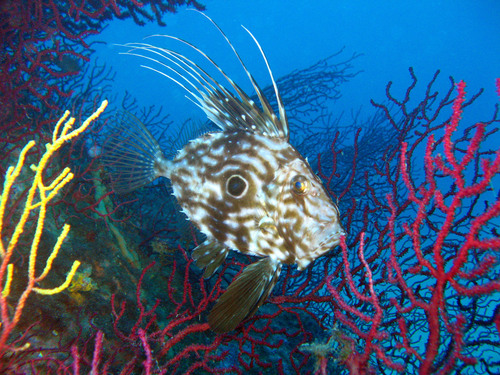
John Dory
The Atlantic bluefin tuna (Thunnus thynnus) is a highly migratory, large pelagic fish prized for its meat. Known for its incredible speed, size, and strength, it's a top predator in the marine ecosystem. This species is highly sought after, leading to significant conservation concerns.
5 12 years
Lifespan
66 cm
Length
Least Concern
Conservation Status
8 km/h
Swimming speed
Carnivorous
Diet
Local Migration
Migration
Appearance Overview
The Atlantic bluefin tuna is renowned for its large, streamlined body, built for speed and endurance.
Color
Dark metallic blue on top with a silvery underside
Body shape
Torpedo-shaped, streamlined
Fins
Two dorsal fins, the first depressible into a groove; small finlets running from dorsal and anal fins to tail
Length
Up to 10 feet (3 meters) commonly, though can reach up to 13 feet
Weight
Typically up to 550 lbs (250 kg), but can reach over 1,500 lbs (680 kg)
Diet
Carnivorous, feeding on a variety of fish, squid, crustaceans, and eels.
Feeding Behavior
Highly active predator that uses speed and coordinated hunting strategies, sometimes forming large schools to corral prey.
Social Behavior
Forms large schools, especially during migration and spawning, but can also be found in smaller groups or solitary.
Commercial Relevance
Extremely high value, particularly in the sushi and sashimi markets, making it one of the most expensive fish in the world.
Conservation measures
Subject to strict fishing quotas, international agreements (ICCAT), and various management strategies aimed at rebuilding populations.
Status
Endangered (varies by region and stock assessment, with some populations classified as critically endangered)
Threats
Overfishing (historically and ongoing in some areas), illegal fishing, bycatch in other fisheries, and climate change affecting prey availability.
Habitat Distribution
Depth Range
0-900 meters, though they are most commonly found in the upper layers of the water column.
Geographic Range
Atlantic Ocean, Mediterranean Sea, and the Gulf of Mexico.
Preferred Environment
Temperate and subtropical waters, both inshore and offshore environments.
Reproduction and Life Cycle
Breeding Habits
Spawns in warm waters, primarily in the Mediterranean Sea and the Gulf of Mexico, with specific spawning grounds identified.
Development Stages
Eggs hatch into larvae that drift with the currents. Juveniles grow rapidly, feeding voraciously. They transition through several life stages before reaching adulthood.
Fecundity
Females are highly fecund, capable of producing up to 30 million eggs per spawning season.
Maturity Age
Matures at 4-8 years, though this can vary depending on environmental conditions and population.
Faqs about John Dory
Where are Atlantic bluefin tuna found?
Bluefin tuna are found in the Atlantic Ocean, from the Mediterranean Sea to the Gulf of Mexico, and from Canada to Brazil.
How long do bluefin tuna live?
They can live up to 40 years, though many do not reach this age due to fishing pressure.
Are bluefin tuna warm-blooded?
Bluefin tuna are warm-blooded, unlike most fish, allowing them to maintain a higher body temperature than the surrounding water.
Are bluefin tuna fast swimmers?
Yes, they are among the fastest fish in the ocean, capable of short bursts of speed up to 43 mph (70 km/h).
Do bluefin tuna migrate?
Yes, they undertake long migrations across the Atlantic for feeding and spawning.
What is being done to protect bluefin tuna?
Efforts include fishing quotas, size limits, seasonal closures, and monitoring of populations.
How many eggs do female bluefin tuna lay?
Females can release millions of eggs per spawning season.
What do bluefin tuna eat?
They primarily feed on fish, squid, and crustaceans.
When do bluefin tuna reach maturity?
They reach sexual maturity at around 4-8 years of age.
Why are bluefin tuna so expensive?
The high demand for sushi and sashimi drives the high price of bluefin tuna.
Copyright @ Nature Style Limited. All Rights Reserved.
 English
English